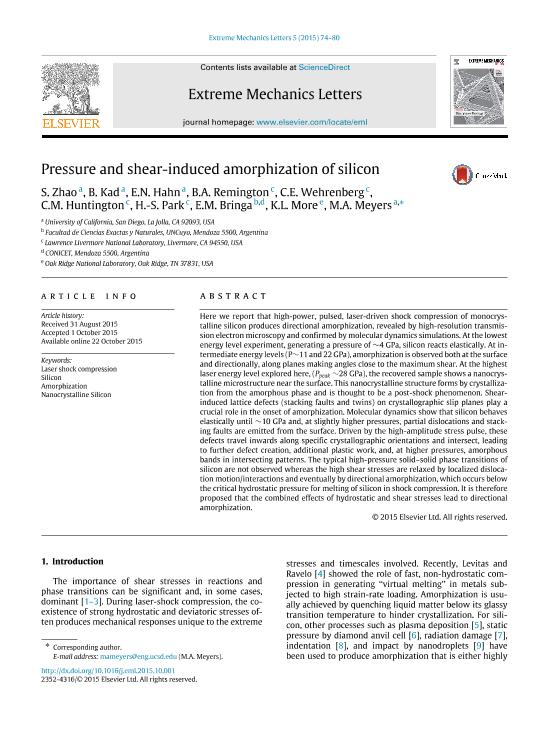Artículo
Pressure and shear-induced amorphization of silicon
Zhao, S.; Kad, B.; Hahn, E. N.; Remington, Bruce A.; Wehrenberg, C. E.; Huntington, C. M.; Park, H. S.; Bringa, Eduardo Marcial ; More, K. L.; Meyers, Marc A.
; More, K. L.; Meyers, Marc A.
 ; More, K. L.; Meyers, Marc A.
; More, K. L.; Meyers, Marc A.
Fecha de publicación:
12/2015
Editorial:
Elsevier
Revista:
Extreme Mechanics Letters
ISSN:
2352-4316
Idioma:
Inglés
Tipo de recurso:
Artículo publicado
Clasificación temática:
Resumen
Here we report that high-power, pulsed, laser-driven shock compression of monocrystalline silicon produces directional amorphization, revealed by high-resolution transmission electron microscopy and confirmed by molecular dynamics simulations. At the lowest energy level experiment, generating a pressure of ~4 GPa, silicon reacts elastically. At intermediate energy levels (P~11 and 22 GPa), amorphization is observed both at the surface and directionally, along planes making angles close to the maximum shear. At the highest laser energy level explored here, (Ppeak ~28 GPa), the recovered sample shows a nanocrystalline microstructure near the surface. This nanocrystalline structure forms by crystallization from the amorphous phase and is thought to be a post-shock phenomenon. Shear-induced lattice defects (stacking faults and twins) on crystallographic slip planes play a crucial role in the onset of amorphization. Molecular dynamics show that silicon behaves elastically until ~10 GPa and, at slightly higher pressures, partial dislocations and stacking faults are emitted from the surface. Driven by the high-amplitude stress pulse, these defects travel inwards along specific crystallographic orientations and intersect, leading to further defect creation, additional plastic work, and, at higher pressures, amorphous bands in intersecting patterns. The typical high-pressure solid-solid phase transitions of silicon are not observed whereas the high shear stresses are relaxed by localized dislocation motion/interactions and eventually by directional amorphization, which occurs below the critical hydrostatic pressure for melting of silicon in shock compression. It is therefore proposed that the combined effects of hydrostatic and shear stresses lead to directional amorphization.
Palabras clave:
AMORPHIZATION
,
LASER SHOCK COMPRESSION
,
NANOCRYSTALLINE SILICON
,
SILICON
Archivos asociados
Licencia
Identificadores
Colecciones
Articulos(CCT - MENDOZA)
Articulos de CTRO.CIENTIFICO TECNOL.CONICET - MENDOZA
Articulos de CTRO.CIENTIFICO TECNOL.CONICET - MENDOZA
Citación
Zhao, S.; Kad, B.; Hahn, E. N.; Remington, Bruce A.; Wehrenberg, C. E.; et al.; Pressure and shear-induced amorphization of silicon; Elsevier; Extreme Mechanics Letters; 5; 12-2015; 74-80
Compartir
Altmétricas



